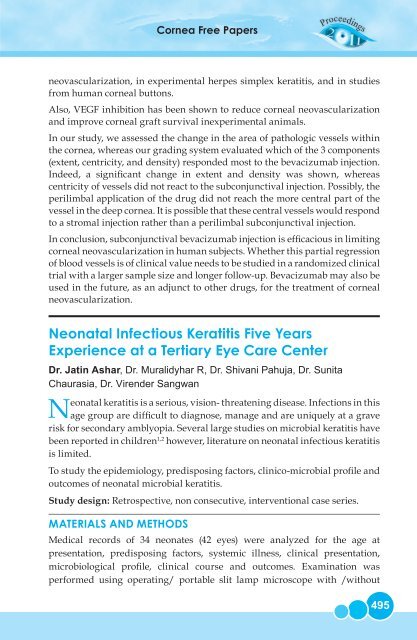Cornea - I Free Papers - aioseducation
Cornea - I Free Papers - aioseducation
Cornea - I Free Papers - aioseducation
You also want an ePaper? Increase the reach of your titles
YUMPU automatically turns print PDFs into web optimized ePapers that Google loves.
<strong>Cornea</strong> <strong>Free</strong> <strong>Papers</strong><br />
neovascularization, in experimental herpes simplex keratitis, and in studies<br />
from human corneal buttons.<br />
Also, VEGF inhibition has been shown to reduce corneal neovascularization<br />
and improve corneal graft survival inexperimental animals.<br />
In our study, we assessed the change in the area of pathologic vessels within<br />
the cornea, whereas our grading system evaluated which of the 3 components<br />
(extent, centricity, and density) responded most to the bevacizumab injection.<br />
Indeed, a significant change in extent and density was shown, whereas<br />
centricity of vessels did not react to the subconjunctival injection. Possibly, the<br />
perilimbal application of the drug did not reach the more central part of the<br />
vessel in the deep cornea. It is possible that these central vessels would respond<br />
to a stromal injection rather than a perilimbal subconjunctival injection.<br />
In conclusion, subconjunctival bevacizumab injection is efficacious in limiting<br />
corneal neovascularization in human subjects. Whether this partial regression<br />
of blood vessels is of clinical value needs to be studied in a randomized clinical<br />
trial with a larger sample size and longer follow-up. Bevacizumab may also be<br />
used in the future, as an adjunct to other drugs, for the treatment of corneal<br />
neovascularization.<br />
Neonatal Infectious Keratitis Five Years<br />
Experience at a Tertiary Eye Care Center<br />
Dr. Jatin Ashar, Dr. Muralidyhar R, Dr. Shivani Pahuja, Dr. Sunita<br />
Chaurasia, Dr. Virender Sangwan<br />
Neonatal keratitis is a serious, vision- threatening disease. Infections in this<br />
age group are difficult to diagnose, manage and are uniquely at a grave<br />
risk for secondary amblyopia. Several large studies on microbial keratitis have<br />
been reported in children 1,2 however, literature on neonatal infectious keratitis<br />
is limited.<br />
To study the epidemiology, predisposing factors, clinico-microbial profile and<br />
outcomes of neonatal microbial keratitis.<br />
Study design: Retrospective, non consecutive, interventional case series.<br />
MATERIALS AND METHODS<br />
Medical records of 34 neonates (42 eyes) were analyzed for the age at<br />
presentation, predisposing factors, systemic illness, clinical presentation,<br />
microbiological profile, clinical course and outcomes. Examination was<br />
performed using operating/ portable slit lamp microscope with /without<br />
495

















